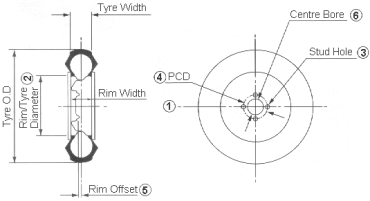Trailer Wheels
There are many different types of wheels fitted to trailers, many of them specifically for trailer use. The practice of using car wheels, rather like that of using car brakes, has largely died out. Wheels, like tyres, have a maximum weight capacity determined by the manufacturer.
Where a wheel/tyre unit maximum weight capacity is declared, if either of the two parts has a different loading capacity, the declared figure will be the lower of the two. Reference should always be made to the supplier if there is any doubt.
The technical terms around a wheel are frequently misused and "rim" and "wheel" are often misused. The main factors to bear in mind, particularly when ordering replacements are as follows:

- Rim: The rim serves as the seat for the tyre.
- Wheel Disc: The wheel disc connects the rim with the hub.
- Wheel: The wheel is the entire assembly, consisting of the rim and disc.
- Rim width: The width inside the wheel flanges and is normally expressed in inches e.g. 4.50.
- Rim diameter: The diameter of the wheel just inside the rim, where the inner edge of the tyre bead sits and normally expressed in inches e.g. 13"
- Offset: The distance between the seating surface of the wheel/hub and the vertical centre line of the wheel/tyre unit. This can be positive offset, as shown above, where the vertical centre line is behind the seating point, when the wheel is fitted to the hub. Negative offset is the opposite and is sometimes known as inset.
- Centre disc: There are also centre disc wheels that have neither positive nor negative offset; i.e. The vertical centre line is in exactly the same plane as the seating point.
- Centre bore: The hole in the centre of the wheel disc, designed to accommodate the bearing boss and grease or dust cap. Size expressed in millimetres.
- Stud or bolt holes: The holes by which either the studs or bolts fasten the wheel to the hub. Normally 4 or 5 in number, the size is determined by the size of the stud or bolt, either metric or imperial. The usual way of expressing the configuration incorporates both these factors, e.g.~
4 x M12 = 4 off 12mm studs or bolts.
5 x M14 = 5 off 14mm studs or bolts.
4 x ½" = 4 off ½" studs.
The seating of the stud hole is also important and must correspond with the seating on the stud or wheel bolt. These are either conical (Straight side walls inside the seating) or spherical (curved side walls inside the seating) but there are some continental wheels with flat cylindrical holes. - Pitch circle diameter (P.C.D.): The diameter of the circle around which the studs are arranged. Measurement given in metric or imperial e.g. 100mm, 112mm, 5.5", 4". The measurement of a 4 stud fixing is simply the distance between the centres of two opposite stud holes. A five stud fixing is calculated by taking the measurement from the centre of a stud hole to the edge of the centre bore x 2 + the diameter of the centre bore.
- Studding patterns: The correct way to express a studding pattern, either of a wheel or of a hub is an amalgam of 9) and 10),
E.g. 4 x M12 on 100mm
4 x 1/2" on 5.5" (or 139.7mm)
5 x M12 on 112mm
- Two piece wheels: Although rarely used as original equipment in today's light trailer market, a number of older trailers may be fitted with two piece wheels, particularly those using 600 x 9 tyres. It is vitally important that the nuts holding the two sections together are NOT loosened whilst the tyre is still inflated.
Essential information when refitting trailer road wheels: Wheel Bolt Tightening




